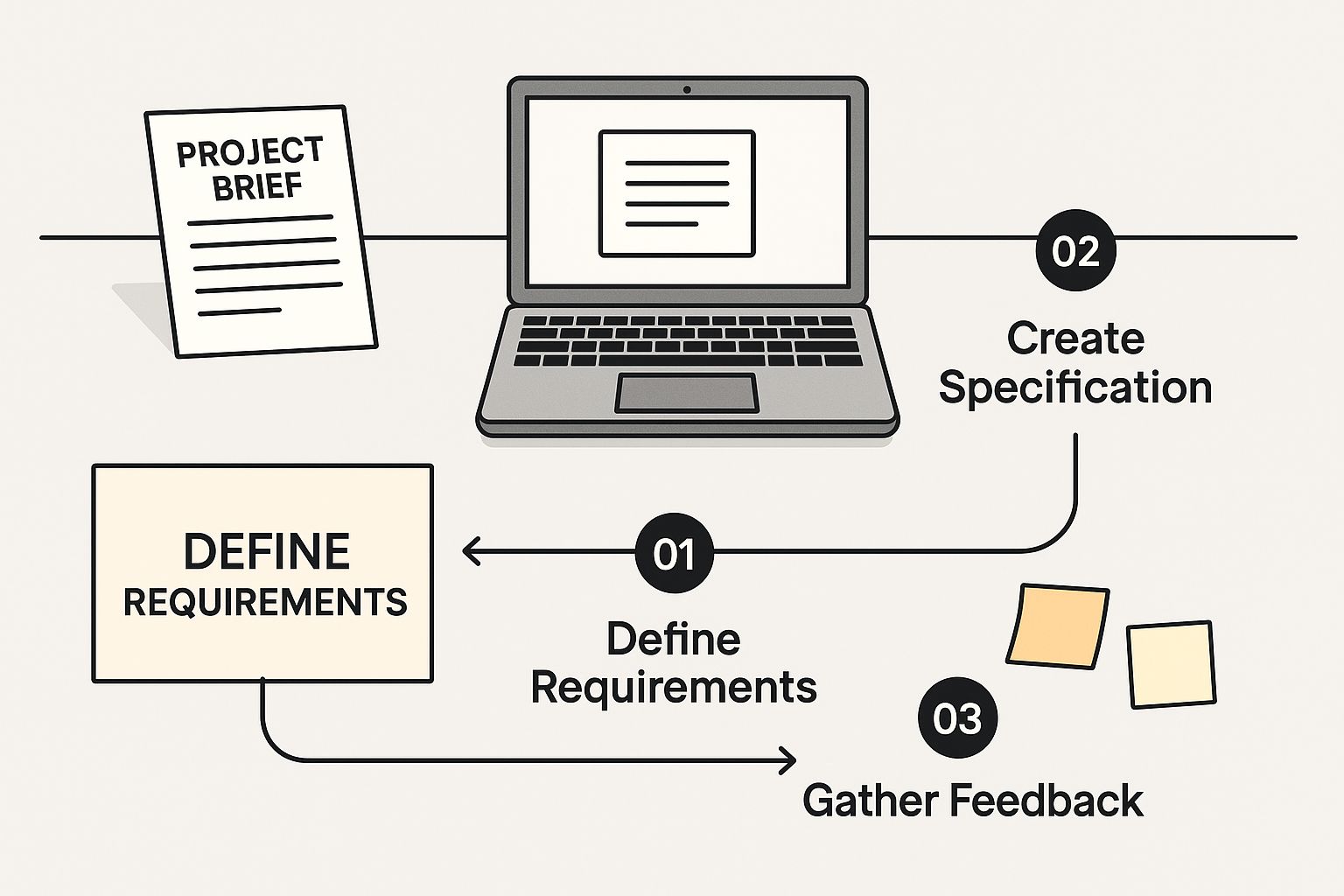If you want to get a handle on scope creep, you have to stop thinking about it as a problem you solve after it happens. The real key is proactive control, not reactive panic.
It all comes down to setting firm boundaries from the very beginning, having a rock-solid process for any changes, and keeping the lines of communication wide open with everyone involved.
Understanding the Real Impact of Scope Creep
Before you can wrangle scope creep, you need to see it for what it is: a silent project killer.
It never barges in and announces itself. Instead, it creeps in with seemingly innocent requests. You’ll hear things like, "Could you just add this one small feature?" or "This should be a quick fix, right?"
On their own, these little additions—often called 'gold plating' when they come from your own team—seem harmless. But they add up. Fast. Each tiny change eats up a little more time, nibbles away at the budget, and pulls your team's focus from the main goal. Before you know it, your deadline is a distant memory, your budget is shot, and your team is burning out chasing a finish line that keeps moving.
The Common Roots of Uncontrolled Changes
Honestly, scope creep usually starts with good intentions but is fueled by poor planning. I've seen it bubble up from a few common sources time and time again:
- Vague Initial Briefs: When project goals are fuzzy from the start, it’s an open invitation for new ideas and interpretations to flood in mid-project.
- Unchecked Stakeholder Enthusiasm: As clients and stakeholders see their project come to life, they get excited. That excitement often turns into a waterfall of "what if we…" suggestions.
- Lack of a Formal Change Process: This is the big one. Without a system to actually evaluate new requests, they get approved in a random email or a casual conversation, completely bypassing any real thought about their impact on time and money.
And this isn't some rare, fringe issue. The Project Management Institute (PMI) found that 52% of projects dealt with scope creep in 2018. That’s a big jump from 43% just five years earlier. The fallout is massive, especially in industries like construction, where a mind-boggling 85% of projects with scope creep blow past their budgets.
The real danger of scope creep isn't the change itself, but the lack of a process to manage it. A single 'quick add' can derail weeks of focused work if not properly evaluated.
Learning to spot the early warning signs is your best defense. The table below breaks down some of the most common red flags I've encountered.
Early Warning Signs of Scope Creep
| Warning Sign | What It Sounds Like | Potential Impact |
|---|---|---|
| Vague Language | "Just make it pop." "Add a bit of wow factor." | Wasted time on subjective revisions that don't align with concrete goals. |
| "Just One More Thing" | "While you're in there, can you also…?" | Accumulates into significant, unbilled work, pushing timelines back. |
| Informal Channels | A quick text message or a comment in a hallway meeting. | Bypasses the formal change process, leading to un-tracked and un-budgeted work. |
| Shifting Priorities | "Never mind that, let's focus on this new idea instead." | Derails progress on core deliverables and can cause team confusion and burnout. |
| Expanding Stakeholders | "I showed this to the CEO, and she has a few thoughts…" | Introduces new opinions and requirements late in the game, often causing major rework. |
Recognizing these phrases is the first step. The goal is to shift the dynamic from simply accommodating every request to collaboratively evaluating every new idea against the project's original mission. This turns potential roadblocks into structured, productive conversations.
For a much deeper dive, you should check out our complete guide on controlling project scope. It lays out the foundation you need to build a project plan that’s tough enough to handle the inevitable pressure for change. When you can spot the threat early, a solid management plan becomes essential, not just a nice-to-have.
Crafting a Bulletproof Project Scope Statement

Let's be real: your best defense against scope creep is a rock-solid project scope statement, sometimes called a Statement of Work (SOW). Don't think of this as just more paperwork. It’s your project’s constitution. This is the document everyone comes back to when those "what if we just…" ideas start flying around.
I've seen projects go south because the foundation was shaky. A weak scope statement is exactly that—a shaky foundation. The entire project becomes unstable and ripe for problems down the line. The goal here is to get everyone on the same page, so aligned that there’s zero room for misinterpretation.
Defining Crystal-Clear Objectives
Before you can even think about listing deliverables, you need to know what success actually looks like. I can't tell you how many times I've seen vague goals become the root cause of chaos. "A new, modern website" sounds nice, but it means nothing.
Get specific. A much clearer objective is: "Develop a five-page responsive website with a new brand identity, including a blog and a contact form, that increases user engagement by 15% within the first quarter post-launch." Now that's a target you can actually aim for.
When your objectives are this clear, it's a piece of cake to look at a new request and ask, "Does this actually help us hit our target, or is it just a distraction?"
Listing Every Deliverable and Boundary
This is where you get into the weeds. Your scope statement needs to spell out everything the project will produce. Don't just write "social media assets." Break it down.
- Five unique Instagram post templates (1080x1080px)
- Three animated GIF templates for Instagram Stories
- One Facebook cover photo update
Just as important is defining what’s out of scope. This little section is your secret weapon against assumptions. If you're building that website, your "out of scope" list might include things like:
- Ongoing SEO services after launch
- Writing the content for the blog posts
- Managing the client's social media accounts
By clearly stating what you won't be doing, you shut down future misunderstandings before they even start. It’s about setting firm, respectful boundaries from day one, which is crucial for successfully managing creative projects. This clarity protects both you and your client from headaches later.
From Vague to Bulletproof
Let’s look at a real-world comparison to see just how big a difference this makes.
| Vague Scope | Bulletproof Scope |
|---|---|
| "Design a new logo." | "Design three unique logo concepts. Client receives two rounds of revisions on the chosen concept. Final deliverables include full-color, black, and white versions in PNG, SVG, and EPS formats." |
| "Create a promotional video." | "Produce one 90-second promotional video. Includes scriptwriting, professional voiceover, and licensed background music. Excludes on-location filming and paid actors." |
See the difference? It's all about precision. The bulletproof version leaves no room for guessing and gives you a clear checklist for what "done" means. If you want to get really good at this part, mastering different product backlog prioritization techniques can help you and the client agree on what's most important right from the start.
This isn't about being difficult; it's about being a professional. A detailed scope statement turns subjective wishes into objective agreements. It gives you a baseline that makes any new request easy to spot, discuss, and handle with a proper change request. For a bigger picture on how this fits into the project lifecycle, our guide on how to manage creative projects is a great place to start.
Look, even with the most ironclad project scope, things are going to change. That’s just the reality of creative work. A key stakeholder gets a flash of inspiration, the market zigs when you expected it to zag, or your own team uncovers a brilliant, better way to tackle a problem.
The goal isn't to slam the door on every new idea. It's about managing change so it doesn't send your project spiraling off a cliff. This is where a formal change control process becomes your absolute best friend.
Think of it as a gatekeeper. It ensures every new "what if" gets a proper look before it lands on the to-do list. Without it, you're running your project on a chaotic mix of random emails and hallway ambushes—and that's a recipe for disaster.
The Heart of the Process: The Change Request Form
At the core of any solid change control process is the Change Request Form (CRF). It’s a simple but powerful document. It takes a casual idea and turns it into a concrete proposal that your team can actually evaluate. It doesn't need to be a 10-page monster, but it must capture the essentials.
You can think of the CRF as a mini-brief for the proposed change. A good one forces everyone involved to stop and think through the real-world consequences of their request. Strong document control best practices are huge here, making sure every CRF is logged, tracked, and never gets lost in someone's inbox.
To make this super practical, here are the essential fields you should include in your own Change Request Form. This isn't just about collecting data; it's about prompting the right conversations from the get-go.
Essential Elements of a Change Request Form
| Field Name | Purpose | Example |
|---|---|---|
| Request Details | Identifies who is asking and what they specifically want. No ambiguity. | "Jane Doe (Marketing Director) requests adding a 'Shop the Look' feature to product pages." |
| Reason for Change | Explains the "why" behind the request. Does it solve a problem or create a new opportunity? | "Competitor X just launched a similar feature. We need this to stay competitive and increase average order value." |
| Impact Assessment | The most critical part. Spells out the effect on scope, timeline, budget, and resources. | "Requires an additional 40 hours of development and 15 hours of design. Estimated cost: $4,500. Pushes launch date back by 1 week." |
| Approval Section | A clear sign-off space for stakeholders to confirm they accept the trade-offs. | "Client Signature & Date," "Project Manager Signature & Date." |
Having a template like this ready to go transforms the entire dynamic. It moves the conversation from "can we?" to "here's what it will take—do we want to proceed?"
Putting It All Into Action
Let's walk through a real-world scenario. A design agency is building a new e-commerce site. Halfway through the project, the client pings them: "Hey, just had a great idea! Can we add a customer loyalty program?"
Instead of the knee-jerk "Sure, we'll look into it," the project manager hits pause and starts the process:
- Submission: The PM sends the client a CRF, helping them articulate the specifics of the loyalty program.
- Evaluation: The dev team gets the form and does their homework. They figure out it'll add three weeks to the project and cost another $5,000.
- Review: The PM walks the client through the completed CRF, clearly laying out the trade-offs. No surprises.
- Decision: Now, the client has all the cards on the table. They can approve the extra time and budget, shelve the idea for a Phase 2, or scrap it altogether.
Here’s a great visual that shows how getting this stuff right from the very beginning sets the foundation for everything else.

As you can see, defining requirements is step one. It's the solid ground you build everything on, including a smart change control process.
By turning a vague request into a concrete decision with clear consequences, the agency stays in the driver's seat. This nips scope creep in the bud while keeping the client relationship open and collaborative.
And the data doesn't lie. Projects with a formal change control process are 50% more likely to finish on time and on budget. We saw a software team implement a change control board and watch their unauthorized feature requests drop by 30%. That directly translated to hitting their deadlines more consistently.
This isn't just bureaucratic red tape; it's a fundamental part of how you manage creative projects without losing your mind.
Using Smart Communication to Align Stakeholders
Even with a rock-solid scope statement and a change control process you could bounce a quarter off of, scope creep has a sneaky way of getting in. It loves to fester in the quiet gaps between meetings, feeding on assumptions and mismatched expectations.
This is where smart, consistent communication becomes your secret weapon for keeping everyone aligned and the project on track.
A well-thought-out stakeholder communication plan is about so much more than just sending emails. It's about making every single interaction count and ensuring everyone knows the project's boundaries from the get-go.
Kickoff Meetings That Set the Stage
Your project kickoff meeting is your first, best shot at getting communication right. This isn’t just a meet-and-greet; it’s a mission briefing. You need to actively walk every single stakeholder through the project scope, the change control process, and exactly how you'll be sharing updates.
Use this time to set the tone. Let everyone know that the scope document is the project's single source of truth. Explain that while new ideas are awesome and welcome, they absolutely must go through the formal change request process to be evaluated. This manages expectations from day one and helps kill those casual "can you just add this?" requests before they even start.
Regular Updates and Transparent Reporting
Silence is the enemy of scope management. Seriously. When stakeholders don't hear from you, their minds start to wander, and that's when their own ideas and anxieties fill the void. You need to establish a predictable rhythm for your project updates, whether that's a weekly email or a bi-weekly sync call.
And when you send those updates, always tie them back to the agreed-upon scope. Something like this works wonders:
- What we did: "This week, we knocked out the user login and profile page designs, just as we planned in the SOW."
- What's tricky: "Heads up, we're hitting a snag with a third-party API integration. This might push back the timeline for the 'Order History' feature."
- What's next: "We got the change request for the loyalty program and we're digging in to see how it affects the budget and schedule. We'll share our findings at the next meeting."
This kind of constant, transparent reinforcement keeps the original goals front and center for everyone. The data doesn't lie: projects with effective communication are 1.5 times more likely to successfully manage scope.
The Art of Saying No (or "Not Right Now")
Let's be real. Sometimes you just have to say no. The trick is to do it constructively, turning a potential "no" into a collaborative decision.
Instead of a flat, "Nope, can't do that," you need to reframe the conversation.
The goal is to shift the conversation from "Can you add this?" to "Let's evaluate this new idea's impact together." This turns you from a gatekeeper into a strategic partner.
When a stakeholder lobs a request that's clearly out of scope, gently guide them back to the project's core objectives. A great way to respond is: "That's an interesting idea. Let's pull up our scope and timeline to see where this could fit. We might need to trade it for another feature or maybe plan it for a future phase. What do you think is the best path forward?"
This approach shows you respect their idea while still protecting the project's boundaries. It reinforces the simple truth that every decision has a trade-off. For more on handling these tricky conversations, check out our guide on client communication best practices. It's packed with real-world tips.
Lessons From High-Stakes Projects

Theory is great, but let's be real—the best lessons come from the trenches. When we look at how massive, high-stakes projects navigated the treacherous waters of scope creep, we get a playbook of what actually works.
It’s almost comforting to know that even the giants wrestle with this stuff. Think about Apple's iPhone X. They were deep into development when they decided to integrate game-changing features like facial recognition and augmented reality. That wasn't in the original plan.
Or look at Tesla's Model 3 production, which was notorious for continuous feature additions that triggered major delays. Even Amazon's Prime Delivery Drones project saw its scope balloon when they added requirements for heavier payloads, creating a ripple effect of new challenges. A great breakdown on how these projects managed evolving demands can be found over at trueprojectinsight.com.
Here's the thing: these projects weren't failures. They were masterclasses in adaptation. The big takeaway is that successful teams don't stop all changes. Instead, they build systems tough enough to absorb and manage them without falling apart.
What We Can Learn From Their Successes
So, what separates a project that artfully weaves in new features from one that collapses under the weight of "just one more thing"? It boils down to a few core principles you can bring to your own work.
-
Have a Process for Change: The big players like Apple don’t fight change; they expect it. They have ingrained change control processes that let them evaluate a new idea's potential without derailing everything. Every proposed feature gets weighed against its real impact on the timeline, budget, and—most importantly—the user experience.
-
Keep Your Eyes on the Prize: Even as shiny new features were added to the iPhone, the core mission never changed: create an intuitive, revolutionary smartphone. That "North Star" vision is crucial. It helps teams distinguish between a strategic addition and a distraction.
-
Be Agile With Your Resources: The teams that handle scope creep best are masters of resource allocation. When a change gets the green light, they don't just cross their fingers. They actively reassign people, adjust budgets, and immediately communicate new timelines to everyone involved. This kind of proactive management is one of the 8 critical project success factors for 2025.
The most successful project leaders don't see scope creep as a threat to be eliminated, but as a reality to be managed. Their goal isn't to build an unbreakable wall around the original plan, but to install a well-guarded gate.
Turning Cautionary Tales Into Strengths
The struggles of projects like the Model 3 are just as valuable. The real friction happened when communication about the impact of those changes broke down. Stakeholders kept adding features, not fully grasping the compounding delays it would cause down the line.
This puts a giant spotlight on the need for a transparent feedback loop.
When someone suggests a change, its true cost—in hours, dollars, and team focus—has to be calculated and communicated clearly. This turns a potentially damaging "yes" into a strategic business decision where everyone understands and accepts the trade-offs. It's how you manage scope creep without killing innovation.
Frequently Asked Questions About Scope Creep
Even with a solid plan, you're bound to run into tricky situations on the ground. When you're in the thick of a project, specific questions always seem to pop up. Here are some quick answers to the common curveballs project managers face when they're getting the hang of managing scope creep.
What Is The Difference Between Scope Creep And Gold Plating?
This is a big one, and getting it right is crucial. Think of scope creep as the stuff clients ask for—new features, tweaks, and "can we just add…" requests that weren't in the original plan. It's usually external pressure pushing the project's boundaries outwards.
Gold plating, on the other hand, is an inside job. It’s when your own team, often with the best intentions, adds extra features or polishes the work way beyond what the client actually asked for. They might be trying to impress the client or just getting carried away. This accounts for a surprising 20% of scope creep issues in creative and IT projects, which tells you that internal discipline is just as important as client management. For a deeper dive, you can check out more insights on gold plating’s impact on projects over at Simplilearn.com.
The key takeaway? Scope creep is usually an external request, while gold plating is an internal habit. You have to be vigilant about both, but they require totally different approaches to get them under control.
How Do I Handle A Stakeholder Who Constantly Suggests Small Changes?
Ah, the "death by a thousand cuts" stakeholder. We've all been there. For the client who loves to drop "tiny" requests into your inbox every other day, the best strategy is to batch them. Don't let them derail you one by one.
Set up a "parking lot" or an "ideas for phase two" list. When a new idea comes in, acknowledge it, thank them for their input, and let them know you’re adding it to the list to review at the next major checkpoint.
This little trick works wonders. Why?
- It shows you’re listening and respecting their input, but it protects your team's focus.
- It forces all the "small" changes to be evaluated together, which suddenly makes their cumulative impact very clear.
- More often than not, when the stakeholder sees all their ideas in one place, they'll realize many of them aren't actually priorities after all.
Can Scope Creep Ever Be A Good Thing?
It sounds crazy, but yes—sometimes. The catch is that it has to be managed correctly. Every once in a while, a new request can unlock a massive opportunity or solve a problem you didn't even know you had.
The real difference here is control. Uncontrolled scope creep will absolutely kill a project. Dead. But when you run a new idea through your change control process and discover it offers huge value, it's a different story.
If the client is on board with the updated timeline and budget, what started as "creep" becomes a strategic pivot. It’s a smart move that can make the final result even better.
Ready to stop scope creep before it even starts? Creativize connects you with experienced local creative professionals who know how to define, manage, and deliver projects on time and on budget. Find the right talent for your next project on creativize.net.

